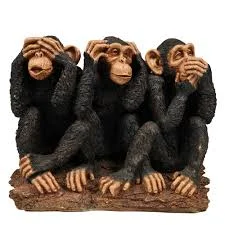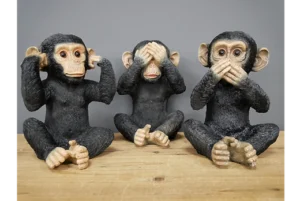The proverb of “see no evil hear no evil speak no evil” comes from the wisdom of three monkeys, representing the idea that avoiding negativity and harmful influences can protect us from malice. Mahatma Gandhi, known for his discipline and focus, exemplified this by staying away from sinful thoughts and actions, allowing him to achieve his goals with clarity and purpose.
In the workplace, an organization’s culture is shaped by the collective actions of its employees. As an individual—whether a leader or a team member—your thoughts, feelings, and actions contribute to that culture. What we focus on grows, and by applying the wisdom of the “See No Evil, Hear No Evil, Speak No Evil” proverb, we can cultivate a positive, productive work environment.
See No Evil: Be Objective and Focused
To “see no evil hear no evil speak no evil” means to approach situations without bias or negativity. It’s about focusing on the core issue at hand rather than getting distracted by the people or circumstances surrounding it. By being objective, we save time and energy, which would otherwise be spent on unproductive emotions or judgments.
For example, when a conflict arises in the workplace, it’s easy to focus on who is involved. However, this often slows down the resolution process. Instead, consider the situation itself and how it can be resolved in the most efficient way. Avoiding subjective views ensures that the issue is addressed quickly and effectively.
This doesn’t mean that we should ignore wrongdoing. If you notice a team member engaging in unprofessional behavior, it’s important to speak up. This approach fosters a culture of improvement and mutual respect, leading to better collaboration and fewer business losses.
Hear No Evil: Be Authentic and Emotionally Intelligent
“see no evil hear no evil speak no evil” means to be authentic and aware of how we respond to the words and actions around us. At work, there are many situations that may trigger negative emotions—such as anger, fear, or jealousy. But instead of letting these emotions overwhelm us, we can use them constructively.
For instance, if you’re upset about losing an important client, instead of letting your anger turn into frustration, use that emotion to drive change. Focus on how you can improve customer relations or reevaluate your approach to avoid similar situations in the future. By responding with emotional intelligence, we can turn negative feelings into opportunities for growth.
Being authentic means acknowledging your emotions, but choosing to act thoughtfully. If you remain centered, even amidst negativity, you will keep progressing toward your goals, silencing the “evil” that threatens to derail your success.
Speak No Evil: Be Mindful and Constructive
“see no evil hear no evil speak no evil” encourages mindfulness—being conscious of what we say and how it affects others. The way we communicate, especially in the workplace, can either build or break relationships. Whether you’re providing feedback or participating in a team discussion, be mindful of your words.
When giving feedback, aim for constructive criticism. Focus on what can be done better, rather than pointing out faults. Be clear and specific in your communication, ensuring that the person receiving the feedback understands how to improve without feeling attacked. This approach not only fosters better teamwork but also enhances productivity and morale.
Avoid getting caught up in gossip or negativity. Instead, focus on solutions. If you hear a lot of negativity around you, seek out opportunities to bring constructive ideas to the table. Surround yourself with positive, forward-thinking individuals who motivate and inspire you to do better.
By following the principles of “See No Evil, Hear No Evil, Speak No Evil,” you can create a work environment where positivity thrives. This ancient wisdom teaches us to focus on the truth, be authentic in our responses, and communicate mindfully. Whether it’s dealing with conflicts, emotional challenges, or team dynamics, these principles can help you navigate the workplace with clarity and integrity.
In conclusion, adopting the mindset of “See No Evil, Hear No Evil, Speak No Evil” allows you to filter out distractions and negativity, enabling you to stay focused on what truly matters. It’s about staying grounded, being objective, and fostering a culture of respect and collaboration. By keeping this ancient wisdom in mind, you’ll be better equipped to succeed in the workplace, no matter the challenges you face.
Movie Quiz: Films Inspired by the “See No Evil, Hear No Evil, Speak No Evil” Proverb
This week’s psychological thriller, Speak No Evil, takes its title from the ancient Japanese proverb, “see no evil hear no evil speak no evil” famously depicted by the Three Wise Monkeys. But this is far from the only film inspired by this timeless saying. In fact, there are numerous movies that either reference or are directly influenced by this proverb. As you explore the quiz below, you’ll discover several examples where the idea of See No Evil, Hear No Evil, Speak No Evil plays a key role.
Before we dive into the quiz, it’s interesting to note that there’s technically a fourth monkey, Sezaru, who embodies “do no evil” by covering his genitals. But, let’s move on and get straight into the quiz!
- True or false: Did Gene Wilder and Richard Pryor team up for their fourth and final collaboration in 1989’s See No Evil, Hear No Evil?
- In 1971’s See No Evil, Mia Farrow plays a blind woman who survives a mass murder and is now being hunted by the killer. Which of her Oscar-winning, musically gifted ex-husbands originally wrote the score (which was later replaced): Frank Sinatra, André Previn, or Woody Allen?
- George Clooney won an Oscar for a film based on the book See No Evil: The True Story of a Ground Soldier in the CIA’s War Against Terrorism. What was the 2005 film?
- Which Oscar-winning actress, the youngest to ever win Best Actress, starred in the 1993 thriller Hear No Evil, portraying a deaf woman pursued by a corrupt cop?
- Speak No Evil is a remake of a 2022 Danish film of the same name, which had a challenging production timeline. The original film was shot over seven weeks, but production was delayed four times over 12 months starting in 2020. What caused these delays?
- True or false: The subject of the 1982 Best Picture Oscar winner, Gandhi, reportedly had one exception to his strict rule of non-possession—a small statue of the Three Wise 8.
In 1936’s Three Wise Monks, the entire cast is made up of animals dressed in suits and dresses. The story features a down-on-his-luck reporter, a corrupt banker, and a family caught in the middle. What iconic chimpanzee role did the star Jiggs play in several 1930s movies?
- Glenn Jacobs, best known as WWE’s Kane, starred as a serial killer in the slasher films See No Evil (2006) and See No Evil 2 (2014).
The proverb “See No Evil, Hear No Evil, Speak No Evil” has been around for hundreds of years, but its meaning has evolved over time. In the Western world, the phrase is often used to refer to the act of turning a blind eye to wrongdoing or choosing not to address immoral or illegal behavior. In this context, a person who “sees no evil, hears no evil, speaks no evil” may ignore a wrong they witness, thus avoiding responsibility for correcting it.
The origin of the saying traces back to a work of art—the 17th-century carving above the door at the Tōshō-gū Shrine in Nikkō, Japan, which depicts three monkeys. One covers its eyes, one its ears, and one its mouth. The sculpture reflects Confucius’ teachings, which urged people to avoid actions that are not in line with propriety.
This ancient wisdom continues to resonate in modern life, from personal conduct to film and literature, and serves as a reminder to act with integrity and mindfulness.
The phrase “see no evil, hear no evil, speak no evil” is often linked to the iconic Japanese proverb and imagery of the Three Wise Monkeys. While the precise origin of this phrase and the imagery remains uncertain, it has become a recognizable symbol in global culture. However, a more comprehensive interpretation expands the proverb into “see no evil, hear no evil, speak no evil, do no evil,” offering deeper moral insights.
The Origins of the Phrase
The concept behind the Three Wise Monkeys can be traced back to ancient Chinese philosophy, particularly Confucianism. This proverb encourages individuals to avoid involvement with immoral or negative actions. Although there are various interpretations of the story, the overarching theme remains the same: it represents a moral code for leading an ethical life, steering clear of negativity through intentional actions, speech, and even thoughts.
The phrase “see no evil, hear no evil, speak no evil, do no evil” closely aligns with Buddhist ethics, particularly mindfulness, right speech, right action, and right livelihood. These teachings guide followers toward enlightenment by helping them eliminate suffering and cultivate wholesome qualities. Let’s break down how these principles correspond to the phrase:
1. Right Mindfulness: See No Evil
Mindfulness is a cornerstone of Buddhist practice. It involves being fully aware of your thoughts, actions, and speech. The principle of “see no evil” is a reflection of mindfulness, urging individuals to avoid exposure to harmful or negative influences. By being mindful, one can avoid the temptation to see or dwell on evil, fostering inner peace and clarity.
2. Right Speech: Speak No Evil
In Buddhism, ethical communication is emphasized as a critical aspect of moral conduct. Right speech encourages individuals to speak truthfully, avoid divisive language, and choose words that promote kindness, harmony, and understanding. The idea of “speak no evil” directly correlates with this principle, serving as a reminder to avoid harmful or unskilled speech that could cause harm to others or oneself.
3. Right Action: Do No Evil
Right action refers to engaging in ethical, compassionate behavior that does no harm. In this context, “do no evil” urges individuals to act in ways that are aligned with ethical principles, encouraging kindness and compassion. Whether it’s personal actions or professional conduct, “do no evil” means making choices that promote well-being and reduce suffering for oneself and others.
4. Right Livelihood: Hear No Evil
The principle of right livelihood stresses the importance of earning a living in an honest and ethical manner, ensuring that one’s work does not cause harm to others.Avoiding harmful influences in the workplace or through professional endeavors aligns with the Buddhist approach to ethical living, promoting positive contributions to society.
Integrating the Four Principles
While the exact phrase “see no evil, hear no evil, speak no evil, do no evil” is not directly found in Buddhist texts, its core values resonate deeply with the teachings of mindfulness, right speech, right action, and right livelihood. These principles guide individuals on their path toward enlightenment, encouraging them to avoid negative influences and engage in actions that lead to moral uprightness and inner peace.
By adhering to these principles, individuals can cultivate a mindful, virtuous life in accordance with Buddhist teachings, reinforcing the timeless message of the Four Wise Buddhas:
Conclusion
The ancient proverb “See No Evil, Hear No Evil, Speak No Evil, Do No Evil” offers timeless wisdom that can significantly impact both personal and professional life. Rooted in Confucianism and Buddhism, these principles guide individuals toward ethical living, fostering mindfulness, right speech, right action, and right livelihood. By applying these concepts in everyday situations, especially in the workplace, individuals can promote a positive, respectful, and productive environment. Whether navigating challenges, resolving conflicts, or interacting with others, the wisdom of the Four Wise Buddhas provides a clear path to moral integrity and personal growth. By practicing these principles, one can lead a life that aligns with ethical values, contributing to both personal well-being and the well-being of the community.
FAQs about See No Evil Hear No Evil Speak No Evil: Applying Ancient Wisdom at Work
What does “See No Evil, Hear No Evil, Speak No Evil” mean in the workplace?
It encourages individuals to avoid negativity and harmful influences, focus on objectivity, respond with emotional intelligence, and communicate mindfully to create a positive and productive work environment.
How does “See No Evil” apply to conflict resolution at work?
It emphasizes addressing the issue objectively without bias or distractions, focusing on resolving the problem rather than assigning blame.
What is the significance of “Hear No Evil” in professional interactions?
It highlights the importance of emotional intelligence and authenticity, transforming negative emotions into opportunities for growth while responding thoughtfully to challenges.
How can “Speak No Evil” improve workplace relationships?
By promoting mindful and constructive communication, avoiding gossip, and offering feedback in a way that fosters understanding and collaboration.
Is there a fourth monkey in the proverb?
Yes, the fourth monkey, Sezaru, represents “do no evil,” emphasizing ethical actions in addition to thoughts, words, and perceptions.
For more information visit publishtechpro





